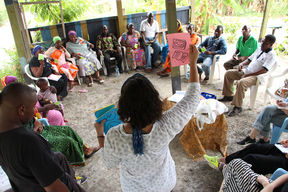Three ways systems thinking supports practicing of humanitarian architecture

Systems thinking is a mindset and a theoretical approach that supports fields that are complex, unpredictable, and challenging, such as humanitarian architecture. In the WiT Programme, systems thinking is one of the key approaches for working in challenging environments. Three key principles of systems thinking – holistic thinking, understanding change processes, and the notion of mental models – are extremely useful for anyone who practices humanitarian architecture, which, shortly, seeks to improve life, environment, and future possibilities of people in vulnerable conditions (Read more at Humanitarian Architecture - What does it mean?).
In this blog, I take a look at the three key principles of systems thinking and discuss their relationship to humanitarian architecture.
1. Holistic thinking in complex situations
First, systems thinking enables you to navigate complexity with holistic thinking. The situations that lead to the need for humanitarian architecture are often extremely complex. Complexity is always present in all human and natural systems, which are inherently unpredictable. Systems change and evolve as there are impacts, feedbacks, and interactions between various scales: small and large, fast and slow. Holistic thinking seeks to embrace an understanding that in any system and situation, there is more going on than meets the eye. Holistic thinking also reminds us that everything is connected to everything else. Some connections may be more impactful than others, and sometimes even small changes in initial conditions can lead to large scale impacts. With holistic thinking, it is possible to evaluate and predict where the system can and should change; for example, how architectural interventions can support humanitarian development.
2. Working with dynamics of change
Another useful set of concepts in systems thinking helps us to understand dynamics of change in systems. We recognize systems from their behavior over time – the patterns, processes, and systemic structures. Humanitarian architecture is always a change-inducing intervention, and thus it is vital to understand how to initiate and support change processes in systems. It is also crucial to recognize that it is sometimes surprisingly difficult to change systems, even if the change would be for the better. System change and resilience are concepts that are closely related to each other. Understanding dynamics of change helps us to find out what to do when things get stuck. Systems thinking, both in theory and in practice, is specialized in conceptualizing and operationalizing the processes of change.
3. Understanding mental models
The third way how systems thinking supports practicing of humanitarian architecture is the notion of mental models which filter our view of the world. We all have our unique way of interpreting and understanding the world around us, based on our culture, our personal experiences in life, and our interests, among other things. Our mental models also change as we learn and get more experience in life. Understanding that our action and ability to create and innovate is always based on our unique set of mental models can help us communicate and work in a supportive, respectful, and productive way with other people.
Systems thinking as a mindset
Systems thinking is basically a mindset, a mental model of its own. It is immensely useful for practical work in the field of humanitarian architecture, as well as in any other field that deals with complexity and change. It helps us to understand various cultural backgrounds, worldviews, and different approaches to solving problems. Systems thinking is also a framework that supports research, analyzing, and scenario building. It is directly linked to other key methodologies in the WiT Programme, such as futures thinking and resilience approach. Most importantly, systems thinking emphasizes a curious, empathetic, and supportive way of thinking about the complex and wicked challenges within which the field of humanitarian architecture is situated.
In our new WiT Programme, systems thinking is one of the central theoretical and practice-linked approaches, together with other practice-tested skills, methodologies, and tools. Read more of the WiT Programme here.






